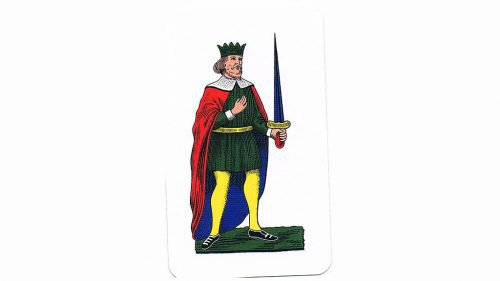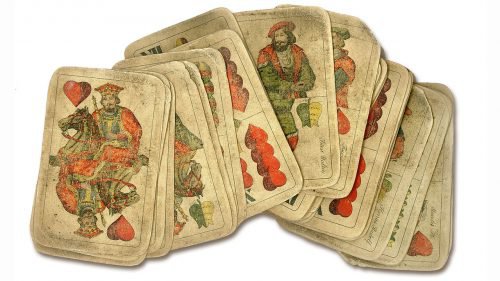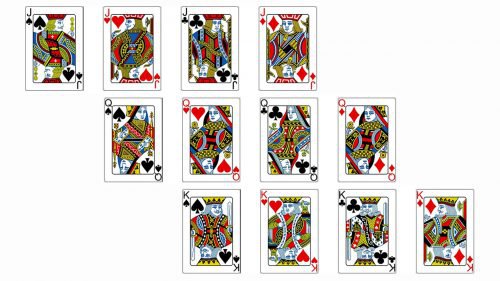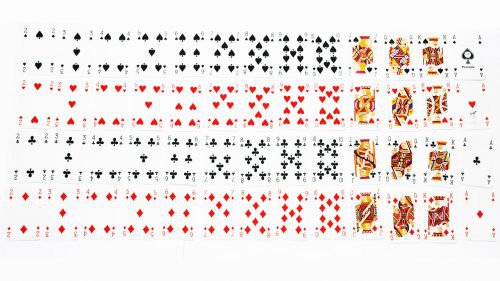
Across the world throughout history, people have used decks of cards. Their exact origin is hard to trace, though it is generally accepted that cards moved from the East to the West, with evidence of their use in China as early as the 9th century. The French lay claims to the invention of the tarot card deck for divination while Britain was the site of the first recorded recreational game.
With such a rich and diverse history, it’s crucial to remember that the symbols on cards are not quite universal. They have changed and adapted over time as a cultural indicator. Pips of goblets and sorcerers, stars and moons as well as birds and bells have all been used instead of hearts and clubs. The face cards have changed according to the society in which they printed.
Still, the symbols on cards offer logo designers clues as to archetypal influences, with hundreds of years of social signals locked within the suits and pictures of a standard 52-card deck. These symbols are evident in branding, as companies have done already.
Interpretations of Card Suits

Caption: A 1930’s deck of cards from Hungary.
The suits of cards, indicated by ‘pips’, are the symbols that most of us know as hearts, clubs, diamonds and spades. As mentioned, the pips changed according to culture and context, but one theory says that the standard suits on European decks represented the hierarchies of medieval society, with clubs (then batons) representing peasants up to hearts for the clergy.
Again, this has not been rigid. Diamonds may have been the top tier in French society, whereas spades are often the highest suit.
However, there are several other symbolic associations of the suits of cards. These will be more useful to companies and logo designers, who can draw on whichever interpretation fits their model and ethos. Some such models include:
- Seasonal Interpretations – Suits have been associated with seasons. Hearts for spring, clubs for summer, diamonds for autumn and spades for winter.
- Stages of Life – This one is a similar interpretation. Hearts are for early age, clubs for youth, diamonds for adulthood and spades for old age.
- Elemental – This one is a mystical interpretation, which associates suits with elements. Hearts are for water, clubs for air, diamonds for fire and spades for the earth.
- Characteristics – Suits have specific characteristics and personality traits. Hearts are for the home, love, emotions and vulnerability. Clubs are for education and intellectual musing. Diamonds are for career, security, responsibility and judgment. Spades are for wisdom, transformation, acceptance and spirituality.
Face Cards
Face cards remained largely unchanged in Europe for many centuries, though small changes have occurred. They are perhaps the most obvious example of hierarchy. In traditional decks, there are four real kings and queens depicted, one for each suit. The British even swapped the value of the king and queen according to who was in power while the Germans removed the queen completely and invented the jack.
The ace introduced later in 1765 and was originally an indicator that there was a tax paid on the playing cards. At that time, it was illegal to forge an ace. To this day, the ace is a prestigious symbol. For instance, PokerStars’ use an ace of spades, usually red but sometimes with variations of colour to create new meaning. In the recent 200 billionth-hand campaign, the symbol appears in gold, as if it implies riches and fortune. Other face cards are not used as much in logos.
Numerical Values
Playing cards also have numerical values, and from a numerological perspective, these can provide value for companies and logo designers, though it is beyond the scope of this article to examine their meanings in full. The meaning of each number tends to evolve from the last one. For example:
- Ace – Desire, hope and
- Two – Seeks the union of two halves.
- Three – Represents opportunity and choice, such as the fork in the road.
- Four – Satisfaction and stability.
- Five – Restlessness and change.
- Six – Adjustment and reflection.
- Seven – Stress followed by victory.
- Eight – Power and control.
- Nine – Surrender and new beginnings.
- Ten – Success and fulfilment but with the risk of collapsing in on itself (1 + 0 = 1).
The symbols and suits of cards are highly symbolic and revealing of cultural imprints and signals. As a result, logo designers can and have utilized these designs to transmit their company message in an impactful way.








